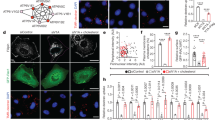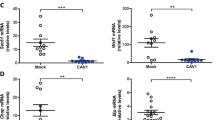Abstract
The plasma membrane pits known as caveolae have been implicated both in cholesterol homeostasis and in signal transduction. CavDGV and CavKSY, two dominant-negative amino-terminal truncation mutants of caveolin, the major structural protein of caveolae, significantly inhibited caveola-mediated SV40 infection, and were assayed for effects on Ras function. We find that CavDGV completely blocked Raf activation mediated by H-Ras, but not that mediated by K-Ras. Strikingly, the inhibitory effect of CavDGV on H-Ras signalling was completely reversed by replenishing cell membranes with cholesterol and was mimicked by cyclodextrin treatment, which depletes membrane cholesterol. These results provide a crucial link between the cholesterol-trafficking role of caveolin and its postulated role in signal transduction through cholesterol-rich surface domains. They also provide direct evidence that H-Ras and K-Ras, which are targeted to the plasma membrane by different carboxy-terminal anchors, operate in functionally distinct microdomains of the plasma membrane.
This is a preview of subscription content, access via your institution
Access options
Subscribe to this journal
Receive 12 print issues and online access
$209.00 per year
only $17.42 per issue
Buy this article
- Purchase on Springer Link
- Instant access to full article PDF
Prices may be subject to local taxes which are calculated during checkout








Similar content being viewed by others
References
Hancock, J. F., Magee, A. I., Childs, J. E. & Marshall, C. J. All ras proteins are polyisoprenylated but only some are palmitoylated. Cell 57, 1167–1177 ( 1989).
Hancock, J. F., Paterson, H. & Marshall, C. J. A polybasic domain or palmitoylation is required in addition to the CAAX motif to localize p21ras to the plasma membrane. Cell 63, 133–139 ( 1990).
Resh, M. Myristylation and palmitylation of Src family members: the fats of the matter. Cell 76, 411–413 ( 1994).
Wedegaertner, P. B., Wilson, P.T. & Bourne, H. R. Lipid modifications of trimeric G proteins. J. Biol. Chem. 270, 503–506 (1995).
Umanoff, H., Edelmann, W., Pellicer, A. & Kucherlapati, R. The murine N-Ras gene is not essential for growth and development. Proc. Natl Acad. Sci. USA 92, 1709– 1713 (1995).
Johnson, L. et al. K-Ras is an essential gene in the mouse with partial functional overlap with N-Ras. Genes Dev. 11, 2468– 2481 (1997).
Bos, J. L. ras oncogenes in human cancer: a review. Cancer Res. 49, 4682–4689 (1989).
Jones, M. K. & Jackson, J. H. Ras-GRF activates Ha-Ras, but not N-Ras or K-Ras 4B, protein in vivo. J. Biol. Chem. 273, 1782–1787 (1998).
Yan, J., Roy, S., Apolloni, A., Lane, A. & Hancock, J. F. Ras isoforms vary in their ability to activate Raf-1 and phosphoinositide 3-kinase. J. Biol. Chem. 273, 24052–24056 (1998).
Hamilton, M. & Wolfman, A. Ha-ras and N-Ras regulate MAPK activity by distinct mechanisms in vivo. Oncogene 16, 1417–1428 (1998).
Simons, K. & Ikonen, E. Functional rafts in membranes. Nature 387, 569–572 ( 1997).
Brown, R. E. Sphingolipid organization in biomembranes: what physical studies of model membranes reveal. J. Cell Sci. 111, 1– 9 (1998).
Parton, R. G. & Simons, K. Digging into caveolae. Science 269, 1398–1399 ( 1995).
Anderson, R. G. The caveolae membrane system. Annu. Rev. Biochem. 67 , 199–225 (1998).
Murata, M. et al. VIP21/caveolin is a cholesterol-binding protein. Proc. Natl Acad. Sci. USA 92, 10339– 10343 (1995).
Fielding, C. J. & Fielding, P. E. Intracellular cholesterol transport. J. Lipid Res. 38, 1503–1521 (1997).
Hailstones, D., Sleer, L. S., Parton, R. G. & Stanley, K. K. Regulation of caveolin and caveolae by cholesterol in MDCK cells. J. Lipid Res. 39, 369–379 (1998).
Fielding, C. J., Bist, A. & Fielding, P. E. Caveolin mRNA levels are up-regulated by free cholesterol and down-regulated by oxysterols in fibroblast monolayers. Proc. Natl Acad. Sci. USA 94, 3753–3758 (1997).
Smart, E. J., Ying, Y., Donzell, W. C. & Anderson, R. G. A role for caveolin in transport of cholesterol from endoplasmic reticulum to plasma membrane. J. Biol. Chem. 271, 29427– 29435 (1996).
Garver, W. S. et al. Altered expression of caveolin-1 and increased cholesterol in detergent insoluble membrane fractions from liver in mice with Niemann-Pick disease type C. Biochim. Biophys. Acta 1361, 272–280 (1997).
Okamoto, T., Schlegel, A., Scherer, P. E. & Lisanti, M. P. Caveolins, a family of scaffolding proteins for organizing “preassembled signalling complexes” at the plasma membrane. J. Biol. Chem. 273, 5419–5422 ( 1998).
Liu, J., Oh, P., Horner, T., Rogers, R. A. & Schnitzer, J. E. Organized endothelial cell surface signal transduction in caveolae distinct from glycosylphosphatidylinositol-anchored protein microdomains . J. Biol. Chem. 272, 7211– 7222 (1997).
Liu, P., Ying, Y. & Anderson, R. G. Platelet-derived growth factor activates mitogen-activated protein kinase in isolated caveolae. Proc. Natl Acad. Sci. USA 94, 13666–13670 ( 1997).
Furuchi, T. & Anderson, R. G. W. Cholesterol depletion of caveolae causes hyperactivation of extracellular signal-related kinase (Erk) . J. Biol. Chem. 273, 21099– 21104 (1998).
Koleske, A. J., Baltimore, D. & Lisanti, M. P. Reduction of caveolin and caveolae in oncogenically transformed cells. Proc. Natl Acad. Sci. USA 92, 1381–1385 (1995).
Engelman, J. A. et al. Recombinant expression of caveolin-1 in oncogenically transformed cells abrogates anchorage-independent growth. J. Biol. Chem. 272, 16374–16381 (1997).
Galbiati, F. et al. Targeted downregulation of caveolin-1 is sufficient to drive cell transformation and hyperactivate the p42/44MAP kinase cascade. EMBO J. 17, 6633–6648 ( 1998).
Anderson, H. A., Chen, Y. & Norkin, L. C. Bound simian virus 40 translocates to caveolin-enriched membrane domains, and its entry is inhibited by drugs that selectively disrupt caveolae. Mol. Biol. Cell 7, 1825– 1834 (1996).
Stang, E., Kartenbeck, J. & Parton, R. G. Major histocompatibility complex class I molecules mediate association of SV40 with caveolae. Mol. Biol. Cell 8, 47–57 (1997).
Roy, S. et al. 14-3-3 potentiates Ras dependent Raf-1 activation in vitro and in vivo. Mol. Cell. Biol. 18, 3947– 3955 (1998).
Stokoe, D., Macdonald, S. G., Cadwallader, K., Symons, M. & Hancock, J. F. Activation of Raf as a result of recruitment to the plasma membrane. Science 264, 1463–1467 (1994).
Way, M. & Parton, R. G. M-caveolin, a muscle-specific caveolin-related protein. FEBS Lett. 376, 108–112 (1995).
Dupree, P., Parton, R. G., Raposo, G., Kurzchalia, T. V. & Simons, K. Caveolae and sorting in the trans-Golgi network of epithelial cells. EMBO J. 12, 1597–1605 (1993).
Wilson, J. M. & Colton, T. L. Targeting of an intestinal apical endosomal protein to endosomes in nonpolarized cells. J. Cell Biol. 136, 319–330 ( 1997).
Porpaczy, Z., Tomasek, J. J. & Freeman, D. A. Internalized plasma membrane cholesterol passes through an endosome compartment that is distinct from the acid vesicle-lysosome compartment . Exp. Cell Res. 234, 217– 224 (1997).
Iwabuchi, K., Handa, K. & Hakomori, S. Separation of “glycosphingolipid signalling domain” from caveolin-containing membrane fraction in mouse melanoma B16 cells and its role in cell adhesion coupled with signalling. J. Biol. Chem. 273, 33766–33773 ( 1998).
Harder, T., Scheiffele, P., Verkade, P. & Simons, K. Lipid domain structure of the plasma membrane revealed by patching of membrane components. J. Cell Biol. 141, 929– 942 (1998).
Brown, D. The tyrosine kinase connection: how GPI-anchored proteins activate T cells . Curr. Opin. Immunol. 5, 349– 354 (1993).
Silvius, J. R. & l’Heureux, F. Fluorimetric evaluation of the affinities of isoprenylated peptides for lipid bilayers . Biochemistry 33, 3014– 3022 (1994).
Murray, D., Ben-Tal, N., Honig, B. & McLaughlin, S. Electrostatic interaction of myristoylated proteins with membranes:simple physics, complicated biology. Structure 5, 985– 989 (1997).
Cooper, M. K., Porter, J. A., Young, K. E. & Beachy, P. A. Teratogen-mediated inhibition of target tissue response to Shh signaling. Science 280, 603–1607 ( 1998).
Hancock, J. F., Cadwallader, K., Paterson, H. & Marshall, C. J. A CAAX or a CAAL motif and a second signal are sufficient for plasma membrane targeting of ras proteins. EMBO J. 10, 4033 –4039 (1991).
Roy, S., Lane, A., Yan, J., McPherson, R. & Hancock, J. F. Activity of plasma membrane recruited Raf-1 is regulated by Ras via the Raf zinc finger. J. Biol. Chem. 272, 20139–20145 (1997).
Gruenberg, J., Griffiths, G. & Howell, K. E. Characterization of the early endosome and putative endocytic carrier vesicles in vivo and with an assay of vesicle function in vitro. J. Cell Biol. 108, 1301– 1316 (1989).
Mu, F.-T. et al. EEA-1, an early endosome-associated protein: EEA-1 is a conserved a-helical peripheral membrane protein flanked by “cysteine fingers” and contains a calmodulin-binding IQ motif. J. Biol. Chem. 270, 13503–13511 (1995).
Kobayashi, T., Stang, E., de Moerloose, P., Parton, R. G. & Gruenberg, J. A lipid antigen associated with the anti-phospholipid syndrome regulates endosome structure/function. Nature 392, 193–197 ( 1998).
Parton, R. G., Way, M., Zorzi, N. & Stang, E. Caveolin-3 associates with developing T-tubules during muscle differentiation. J. Cell Biol. 136, 137–154 ( 1997).
Ullrich, O., Reinsch, S., Urbe, S., Zerial, M. & Parton, R. G. Rab11 regulates recycling through the pericentriolar recycling endosome. J. Cell Biol. 135, 913 –924 (1996).
Song, S. K. et al. Co-purification and direct interaction of Ras with caveolin, an integral membrane protein of caveolae microdomains. Detergent-free purification of caveolae microdomains. J. Biol. Chem. 271, 9690–9697 (1996).
Luetterforst, R., Stang, E., Zorzi, N., Carozzi, A., Way, M., and Parton, R.G. Molecular Characterization of caveolin association with the Golgi complex; identification of a cis Golgi targeting domain in the caveolin molecule. J. Cell Biol. (in the press).
Acknowledgements
We thank D. James, J. Gruenberg, R. McPherson, and G. van Meer for discussions. We also thank M. Way, J. Gruenberg, V. Gerke, B. Hock-Toh, and T. Nilsson for providing antibodies and constructs, and N. Zorzi, A. Lane, and C. Allen for excellent technical assistance. This research was supported by grants from the National Health and Medical Research Council of Australia to R.G.P. and J.F.H. J.F.H. is also supported by the Royal Children"s Hospital Foundation, Queensland. The Centre for Molecular and Cell Biology is a Special Research Centre of the Australian Research Council.
Correspondence should be addressed to J.F.H.
Author information
Authors and Affiliations
Corresponding author
Rights and permissions
About this article
Cite this article
Roy, S., Luetterforst, R., Harding, A. et al. Dominant-negative caveolin inhibits H-Ras function by disrupting cholesterol-rich plasma membrane domains. Nat Cell Biol 1, 98–105 (1999). https://doi.org/10.1038/10067
Received:
Revised:
Accepted:
Published:
Issue Date:
DOI: https://doi.org/10.1038/10067
This article is cited by
-
TGFβ-induced changes in membrane curvature influence Ras oncoprotein membrane localization
Scientific Reports (2022)
-
Impairment of Fas-ligand–caveolin-1 interaction inhibits Fas-ligand translocation to rafts and Fas-ligand-induced cell death
Cell Death & Disease (2018)
-
The Nogo-B receptor promotes Ras plasma membrane localization and activation
Oncogene (2017)
-
Lipids, lipid metabolism and Kaposi’s sarcoma-associated herpesvirus pathogenesis
Virologica Sinica (2017)
-
Farnesylated and methylated KRAS4b: high yield production of protein suitable for biophysical studies of prenylated protein-lipid interactions
Scientific Reports (2015)



